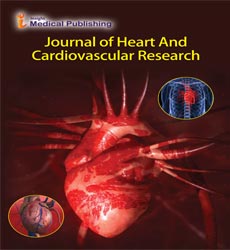ISSN : ISSN: 2576-1455
Journal of Heart and Cardiovascular Research
Heart Organoids for Anthracycline Drug Testing
Shengbo Chen*
Department of Cardiovascular Medicine, The University of Tokyo, Tokyo, Japan
- *Corresponding Author:
- Shengbo Chen
Department of Cardiovascular Medicine, The University of Tokyo, Tokyo,
Japan,
E-mail: shengbo@gmail.com
Received date: May 09, 2024, Manuscript No. IPJHCR-24-19370; Editor assigned date: May 13, 2024, PreQC No. IPJHCR-24-19370 (PQ); Reviewed date: May 29, 2024, QC No. IPJHCR-24-19370; Revised date: June 05, 2024, Manuscript No. IPJHCR-24-19370 (R); Published date: June 12, 2024, DOI: 10.36648/2576-1455.8.2.71
Citation: Chen S (2024) Heart Organoids in Anthracycline Drug Evaluation. J Heart Cardiovasc Res Vol.8 No.2: 71.
Description
The human heart is the first functional organ formed during embryonic development, used to pump nutrients, hormones, proteins and waste products. The heart is one of the most difficult organs to model in vitro because it is a complex structure, not just a hollow structure, made up of multiple layers of tissue and different cell types that work together to ensure proper function. Once the heart is damaged, it cannot be restored by regeneration. However, due to the influence of human age, lifestyle and complex environmental factors, the deterioration of heart function has brought a heavy burden on people's health.
Drug discovery
Cardiovascular diseases, such as myocardial infarction and heart failure, remain the leading causes of death worldwide, accounting for approximately 170,000 deaths worldwide each year. 2D monolayer cultures of cardiac cells, such as the H9c2 cell line and in live animal models, such as mice or zebrafish, have been widely used in cardiac research. However, cellular models do not simulate the structure and heterogeneity of real organization, while interspecies differences between animal models and humans result in poor predictability of cardiovascular toxicity. These traditional models have their limitations and are not fully suitable for studying the physiology and pathology of the human heart. Organoids are 3D models directly induced by human stem cells, which are very similar to human organs and can mimic the development process, physiological and pathological state of human organs and tissues. Cardiac organoids contain essential cardiac cells, such as cardiomyocytes, cardiac fibroblasts and endothelial cells, which can spontaneously shape the shape and function of human heart tissue. With special advantages such as high throughput and reliable clinical relevance, cardiac organoids can compensate for the shortcomings of traditional models for cardiac research and become an important bridge between human and cellular models. Advances in drug discovery and development have greatly contributed to clinical treatment and improved patient survival. However, many chemotherapy drugs cause side effects and cardiovascular toxicity is one of the most common and lifethreatening side effects. Drug-induced cardiotoxicity can disrupt the normal physiological function of the cardiovascular system and lead to serious cardiovascular disease. Clinical manifestations of drug cardiotoxicity are diverse, mainly including cardiomyopathy, arrhythmias, valvular lesions, myocarditis, pericarditis, heart failure and myocardial ischemia. Although safety assessments of all clinical drugs have been obtained in studies, cardiotoxicity is still very common in clinical practice. Current cardiotoxicity assessment methods have disadvantages such as low clinical relevance, reproducibility and low processing power. The transfer of traditional models to human subjects is limited. In addition, many mechanisms regulate cardiotoxicity. Methods and indicators commonly used in clinical practice to detect cardiotoxicity, such as electrocardiogram and echocardiography, are often insufficient to predict the degree of cardiac damage because they are not timely and sensitive.
Drug safety assessment
Cardiotoxicity is a major problem in drug development and public health. Establishing accurate and reliable models or methods to evaluate drug cardiotoxicity is an urgent problem in drug safety evaluation and toxicology. At the same time, the study of more sensitive and accurate indicators or biomarkers to assess cardiotoxicity is also a major challenge in clinical drug safety assessment. As a new generation of in vitro models, heart organoids largely preserve the biological properties and functions of the human heart and can more accurately reflect the effects of drugs on the heart. These unique advantages make heart organoids suitable tools for drug testing and can provide new information that other heart models in traditional preclinical studies cannot provide. Anthracyclines are effective chemotherapeutic agents in the treatment of malignancies such as lymphoma and breast cancer, but their clinical use is associated with severe and potentially life-threatening cardiotoxicity. Doxorubicin, the most widely used anthracycline causes irreversible myocardial damage. However, due to its effectiveness, doxorubicin is still one of the most effective anticancer drugs in clinical practice and is widely used in clinical practice. The molecular pathogenesis of doxorubicin-induced cardiotoxicity is very complex and not fully understood. Although there is still much controversy the mechanism of doxorubicininduced cardiotoxicity has been extensively studied. According to the present study, many molecular elements are involved in the pathogenesis of doxorubicin cardiotoxicity, including apoptosis, DNA damage, transcriptional changes, inflammation and mitochondrial damage.
Open Access Journals
- Aquaculture & Veterinary Science
- Chemistry & Chemical Sciences
- Clinical Sciences
- Engineering
- General Science
- Genetics & Molecular Biology
- Health Care & Nursing
- Immunology & Microbiology
- Materials Science
- Mathematics & Physics
- Medical Sciences
- Neurology & Psychiatry
- Oncology & Cancer Science
- Pharmaceutical Sciences
